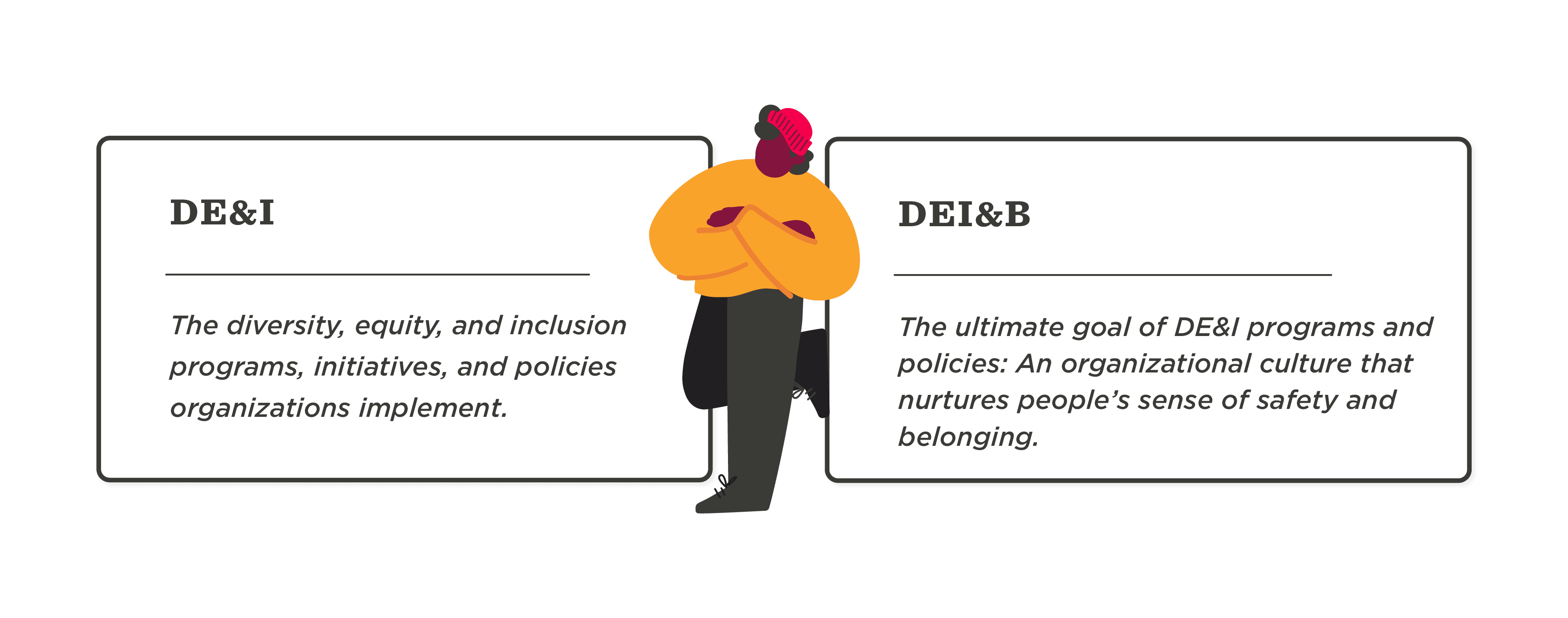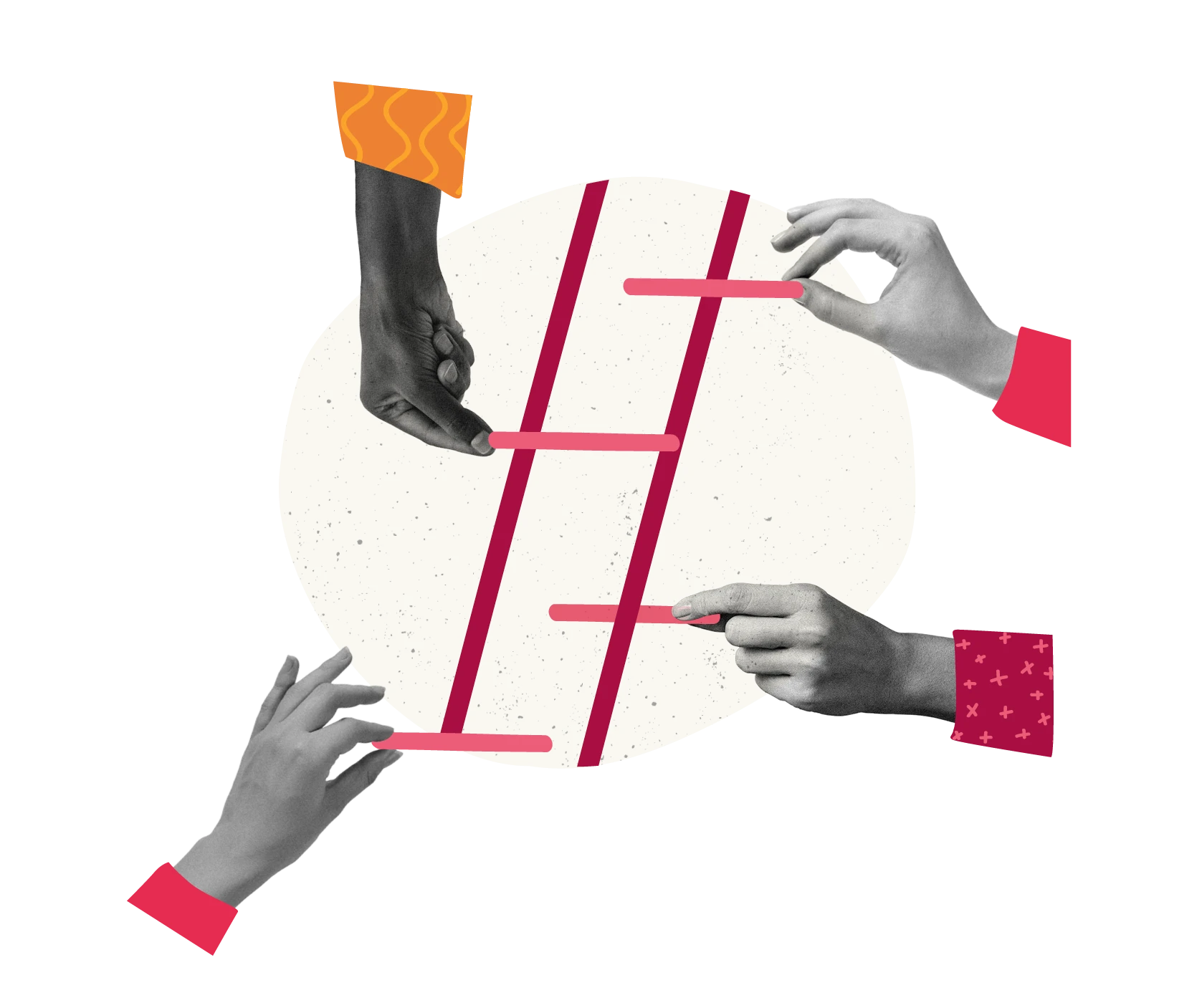Introduction
Diversity, equity, inclusion, and belonging (DEI&B) has shot to the top of the corporate agenda as people have embraced the need for genuine change. Business leaders have recognized that investing in DE&I is good for business: It attracts top talent, customers, and prospects who value and support inclusive and diverse organizations that make a genuine commitment to protecting all of their people.
Research by Deloitte backs up the case and shows that “by emphasizing DEI on all levels of the organization and increasing the opportunities available to frontline workers [many of whom are minorities], organizations could gain loyalty from both their workforce and customers.”
The same research shows that organizations with effective inclusion policies enjoy 50 percent lower turnover than those without. And research by McKinsey shows that organizations with high gender and ethnic diversity have higher profitability margins than their competitors.
But the tides are changing. A growing “anti-woke” movement condemns DE&I initiatives, claiming they create inequalities.
Practitioners created these programs to help build and nurture organizational cultures where everyone feels safe and belongs, regardless of their gender or cultural, political, ethnic, religious, and socioeconomic background.
When organizations implement DE&I programs well, they drive loyalty to the brand (from customers, prospects, and team members) and improve business outcomes—creating a strong business case for their implementation.
“Systemic inequities not only exist in modern workplaces, they continue to shape how organizations make decisions and how employees experience the world of work,” says Sarah Reynolds, Chief Marketing Officer at HiBob. “Addressing these inequities—even making small improvements—can make folks who have long benefitted from the disparities feel uncomfortable. The pushback on DE&I programs clearly signals that actually, there are folks who like things the way they are, and who do not want to see progress that levels the playing field.”
Clarifying terms: DE&I vs. DEI&B

But why? And how can HR professionals continue to champion DEI&B (and improve it, even in the face of social and legal pushback)—while simultaneously prioritizing compliance?
First, let’s look at the legal DE&I landscape
The legal pushback against DE&I is gathering momentum, with decisive rulings like the United States Supreme Court’s (SCOTUS) 2023 decision deeming affirmative action illegal in higher-education admissions. In the immediate wake of this ruling, Governor Greg Abbott of Texas also publicly condemned DE&I in the workplace, causing many to speculate that workplace DE&I policies would be the next to be challenged.
Their fears have now begun to come true. Since 2023, 28 American states have introduced a total of 85 anti-DE&I bills to limit DEI&B departments, professionals, and training programs; diversity statements; and race- and identity-based hiring practices.
Fourteen of these bills have become law.

DEI&B in the age of challenge
To understand why there’s so much pushback against DE&I programs—and to successfully identify how we can continue and even improve them despite these challenges—we first need to unpack the arguments against them.
The goal of DE&I programs is to build a better world where all people feel safe and included. But opponents argue that instead of improving diversity, inclusion, equity, and belonging, they’ve excluded people and decreased people’s sense of belonging and safety.
They argue that DE&I programs focus on specific groups of people at the expense of others and that to genuinely achieve their goals, organizations must apply initiatives equally to everyone, regardless of race, gender, age, ethnicity, religion, socioeconomic background, or ability. In short, they want to prioritize equality over equity.
Recommended For Further Reading
Understanding traditional approaches to DEI&B
But how did we get here?
Organizations started prioritizing DE&I initiatives to address historical inequities. To achieve inclusivity, diversity, and belonging, organizations have traditionally started with anti-bias training programs, policies that keep them in compliance with equal opportunity legislation, and initiatives that focus on race and gender.
But DE&I programs are not a monolith. In a recent interview with HiBob, Lily Kriegs, inclusive culture and belonging partner at Spryker, said: “What we actually need is not a focus on how we’re diverse and different but how we’re alike. During these divisive times, belonging is what keeps us together. To achieve feelings of belonging, we can shift our approach to DE&I programs and how we frame them. The new aim can be finding common ground instead of concentrating only on hiring specifically for diverse representation, which can lead to divisive conflicts.”
To find common ground, it’s critical to acknowledge that it’s possible for any person to feel excluded, unsafe, or discriminated against, regardless of their identity, background, or personal situation, but in different ways.
For example, there’s growing evidence of promotion bias and pay disparities between remote, hybrid, and on-site team members. Genuinely inclusive DE&I programs apply to different types of team members (whether full-time, part-time, contractor, or freelancer), to people with different work structures and locations, and to people of different identities and backgrounds (whether racial, ethnic, socioeconomic, religious, etc.).
Embracing and upholding DEI&B’s core values
At their core, DE&I programs should continue to work towards achieving belonging, Lily Kriegs says. To understand whether your DE&I programs uphold this core value and whether you’re currently structuring your programs to meet belonging goals and protect people from harm, ask the following questions:
- How does diversity bring your team members together and make you stronger rather than divide and create conflict?
- What kinds of programs will emphasize what people have in common?
- How are you educating your people about why differences are a strength that can empower them, not an obstacle to be overcome?
- How do you recognize and remedy situations where employees may be facing discrimination or bias related to aspects of their identity?
- How will you ensure you remain in compliance with local and national equal opportunity laws across every location you operate in?
Company cultures that genuinely nurture belonging promote an environment where every single one of your people feels included, respected, accepted, and protected.
“Make no mistake: Belonging is not the same as fitting in,” Reynolds says. “To truly create a culture of belonging, organizations have to work to remove the obstacles that prevent folks from feeling safe about bringing their authentic selves to work. The goal is an environment where everyone sees and accepts their colleagues as they really are. You have to see me, the real me, including the things that make my experience different from others, for me to feel like I belong.”
Championing a culture of belonging with this goal helps create a strong foundation for new and more effective approaches to achieving DEI&B in the workplace.

8 creative ways to champion DEI&B
Despite the latest rounds of social pushback and anti-DE&I legislation, DEI&B remains a priority for many modern professionals, customers, and prospects—especially Millennials and Gen Zers.
A focus on DEI&B is still indispensable for recruitment and retention practices. But the question is, how do you champion DE&I programs in a way that resonates positively with everyone and keeps you compliant?
“As the law inevitably evolves in a more conservative direction,” Kenji Yoshino and David Glasgow say in a recent HBR article, “the new legal standards will be absorbed into the field of DEI, transforming it as an enterprise … smart organizations can avoid a lot of pain and expense by thinking about how to adapt in a more intentional way.”
The solution to the resistance against DE&I initiatives is not to eliminate them. Rather, the changing compliance landscape requires practitioners to evolve new approaches to enhance organizational cultures that genuinely protect people, promote inclusivity, and create a real sense of belonging for everyone.
1. Take a diverse slate approach to hiring
“Rather than giving ‘preference’ to some groups, organizations can explore DEI actions that are identity-neutral but remove bias from the workplace,” Yoshino and Glasgow say. “Even under a worst-case scenario legal landscape, such leveling approaches will remain legal, because anti-discrimination law only applies when some people are treated differently from others.”
One way to “avoid preferences” is to take a diverse slate approach to hiring. This approach can serve as the backbone of building a culture that facilitates a richer environment for innovation and creativity. It helps bring together a wide range of perspectives and steer clear of “[lifting] certain groups above others [while leveling] the playing field for everybody.”
The key to a diverse slate hiring strategy involves hiring managers and recruiters actively seeking candidates from various backgrounds with diverse experiences and viewpoints—ideally, reflecting the demographics of your customer base. By incorporating these diverse perspectives into your workforce planning and recruitment strategies, you can make more informed decisions about your talent needs.
To achieve a successful diverse slate approach, close collaboration between HR, hiring managers, and recruiters is critical. Here are some key strategies you can take together:
- Adopt blind hiring practices. This can involve redacting identifying information from resumes during the initial candidate screening process.
- Diversify recruitment channels. Look beyond traditional job boards and explore channels that reach a wider range of people from different locations and demographic backgrounds.
- Use inclusive job descriptions. Use inclusive language in your job descriptions and focus on the skills and qualifications needed for the role to encourage people of all backgrounds and identities to apply.
2. Prioritize skills-based hiring, L&D programs, and internal mobility
Hiring from a diverse slate based on skills ensures you stay compliant while still providing equal opportunities for all people. L&D programs and internal mobility efforts can provide team members with a sense of continued support and ensure everyone has the chance to grow, progress, and move both up and laterally in the organization.
It’s not about diversity at the sacrifice of merit, but about creating a level playing field where everyone, regardless of their background, has an equal opportunity to learn, enjoy recognition, and grow professionally.
3. Measure how diverse your employee population is (without risking compliance issues)
It’s important to remember that measuring diversity isn’t just about race and gender. True diversity includes all identities, experiences, and backgrounds.
To measure your workforce’s diversity without risking legal challenges, approach diversity from as many angles as possible. Ask your people questions that provide information about:
- Where they live
- Whether they’re remote, hybrid, or on-site
- Their tenure and level of seniority
- Their areas of expertise
- Other intersectional areas of their identity

4. Track internal data
Achieving DEI&B is about so much more than simply tracking representation in the workplace. It’s about creating a trusting work environment where people feel like they’re safe and belong.
To nurture these qualities in your workplace effectively, tracking them is essential.
But how? It’s critical to connect the dots between traditional people data and your DE&I initiatives. You can do this by:
- Measuring engagement and performance. What do your organization’s engagement and performance levels tell you about your people’s feelings of belonging and satisfaction?
- Conducting surveys. Ask your people questions that can help you gauge their sense of safety, belonging, satisfaction, and connection to their workplace community:
- Do you have everything you need to do your job? (This gauges whether people have equitable support.)
- How do you feel about stating your opinions out loud? (This can give you a good idea of a person’s feelings of trust and psychological safety in the workplace.)
- Do you feel you contribute to the company and that your work makes an impact? (This can give a good indication of how much a person feels that their organization acknowledges their efforts and values them.)
- Can you talk to your manager about sensitive issues? (This can show whether a person feels safe and trusts their team.)
- Do you get frequent and useful feedback? (This can show whether a person feels that their manager wants to help them succeed in their role.)
- Asking people to self-identify on their employee profiles. You can ask people to voluntarily self-identify across a variety of parameters, storing that information securely and confidentially on employee profiles in your HRIS. This will help you organize and assess people’s responses based on representation.
- Or, ask people to self-identify without revealing who they are. Including anonymous questions about work arrangements, identity, and membership of other groups on your employee engagement surveys allows you to conduct the same analysis about responses without permanently capturing data on team members who may not be comfortable with self-ID.
“Employee engagement surveys are an incredible tool for understanding how employees perceive your culture—especially when it comes to inclusion and belonging. Asking folks if they’d like to tell you a bit about how they identify, alongside questions about whether or not they belong, feel seen, or feel equitably rewarded and resourced, will quickly give you an anonymous snapshot of where your organization may have gaps,” Reynolds says.
5. Focus on inclusion
HR industry analyst Josh Bersin suggests focusing on building a diverse and inclusive culture instead of “education and awareness-building led by chief DEI officers.”
This more practical approach, coupled with the support of data that demonstrates the value of diversity for an organization, ensures workplaces authentically walk the talk when it comes to DEI&B.
The fact is, setting hiring targets may not be enough “because if the company is not inclusive in its culture, hiring targets simply fail,” Bersin says.
Similarly, focusing on meeting diversity-related targets easily becomes a “numbers game, a box-checking exercise,” says Ryan Whitacre, Executive Recruiter at Bridge Partners. “Do we have X number of Black people, X number of Asian people?’ And that was effectively the point of the SCOTUS decision: No more race-based thumbs on the scale.”
When it comes to DE&I, Whitacre suggests HR leaders “think about strategies to amplify the ‘E’ and the ‘I.’”
The goal is to include everyone, ensuring every team member feels safe and that they belong.
6. Set goals instead of quotas
Yoshino and Glasgow argue that DE&I programs can minimize legal risk by prioritizing inclusion and diversity goals rather than focusing solely on protected groups. They recommend that organizations achieve this by:
- Up-shifting: Instead of limiting participation in DE&I programs to members of particular protected groups, open participation to people of all demographic backgrounds
- Down-shifting: Consider someone’s identity only when it speaks to their individual character (e.g., this would be legally sound if an applicant to an internship or job discusses how their race, gender, etc. affects them)
- Side-shifting: Adopt programs that advance socioeconomic diversity without considering race, gender, ethnicity, etc.
Instead of focusing on filling quotas and ticking boxes, set goals around the success of programs that make your organization more diverse (e.g., hiring practices), equitable (e.g., pay transparency and equality), and inclusive (e.g., benefits packages with something for everyone).
7. Benefits packages fit for all
It’s important that benefits packages meet the needs of everyone in your organization.
For example, paid parental leave may benefit a specific demographic (new parents). However, as great as that is, it can make others feel excluded if you don’t offer them a comparable benefit.
Offer alternative benefits for people who don’t fit within a particular demographic, like grandparental leave or a work-from-anywhere policy. It helps to give your people the option to choose from a range of benefits that suit their various needs and lifestyles.
8. Use new vocabulary
Rebrand your DE&I starting with the words you use to talk about it.
Reframe the messaging you attach to your DE&I initiatives by moving beyond buzzwords toward highlighting real results and the positive, tangible impact on all your people.
Focus on the goals DE&I is there to achieve: higher rates of psychological and physical safety, feelings of belonging, and equity across the business. You can also focus on business benefits such as improved performance, better brand perception, and greater innovation.

Use people data to prove the ROI of DEI&B
Because DE&I programs are often the first to go during budget cuts, proving the ROI of DEI&B with data is essential to ensure continued support for them.
Take the time to consistently monitor your people data—like performance, engagement, and turnover rates—and how it relates to your DEI&B goals. This can give you insights into how effective your organization’s initiatives are, where they fall short, and what you can do to improve them. It allows you to capture the full ROI of your talent, helping you thrive in the long run.
By monitoring the data closely, you’ll be able to gather measurable results from your initiatives—and real proof of their impact on the business and on the lives of your people.
Championing DEI&B for everyone
The latest wave of “anti-woke” legislation and social pushback presents an opportunity for us to find ways to continue and improve DE&I initiatives. This means ensuring initiatives truly meet the needs of everyone in the workplace so that every team member feels safe, protected, and like they belong.
Lily Kriegs says: “Focus on your organization, not saving the world. Our goal is to create a better space in our workplaces for people from different cultures to work together and thrive.”
Focusing first on making a difference in your organization will increase the impact of your efforts and contribute to the greater good from your small corner of the universe. Even small changes to the way your organization operates may have big impacts on your culture.
Championing DEI&B with new approaches is key to turning the tide for the greater good: New approaches will benefit the business, keep you compliant, and help your company stand out positively with both sides of the DE&I public divide.
